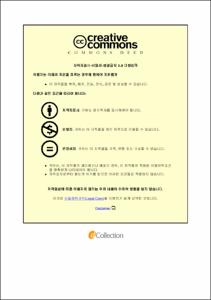Inhibitory Effect of Ecklonia cava Phlorotannin on Vocal Fold Fibrosis: In vivo and In vitro Study
- Alternative Title
- 성대 섬유화에 대한 감태 플로로타닌의 억제 효과: In vivo와 In vitro 연구
- Abstract
- 성대 섬유화(Vocal fold fibrosis)는 체내의 재생 및 반응 과정에서 섬유아세포(Fibroblast)의 비정상적인 증식(Proliferation) 및 분화(Differentiation)로 인해 섬유성 결합조직이 과도하게 형성되는 상태를 의미한다. 특히, 재생 과정에서는 손상 부위에서의 섬유모세포의 이주(Migration)와 증식, 섬유모세포(Myofibroblasts)에 의한 세포외 기질(Extracellular matrix, ECM)의 과도한 축적에 따라 진행되며, 선천적 및 후천적 요인에 의해 다양하게 발병하는 것으로 알려져 있다.
이러한 성대 섬유화를 예방 및 치료하기 위해 여러 연구가 진행되었으나 현재까지는 항암제로 쓰이며, 다양한 부작용을 지닌 마이토마이신 C (Mitomycin C)와 부데소나이드(Budesonide)와 베타메타손(Betamethasone)과 같은 당질 코르티코이드(Glucocorticoid) 계열의 치료제 이외에는 마땅한 성대 섬유화 치료제는 없는 실정이다. 이에 본 연구에서는 성대 섬유화를 예방 및 치료를 위한 생리활성물질을 해양으로부터 찾고자 본 연구를 진행하였다.
본 연구에서는, 해양 생물 중 항염증, 항산화, 항암, 항당뇨 등 다양한 생리활성 효과를 지닌 것으로 알려진 감태 플로로탄닌(Ecklonia cava phlorotannin)을 이용하여 성대 섬유화 예방 및 치료 효과를 확인하였다. 그 결과, 1470 nm 레이저 조사를 통해 성대 섬유화가 유도된 토끼 모델에서의 성대 섬유화와 극심한 염증 반응을 감소시켰으며, 인간 유래 성대 섬유아세포(Human vocal fold fibroblast, hVFFs)에 대하여 전환성장인자-베타1(Transforming growth factor-β1, TGF-β1)의 자극에 의해 증가된 1형 아교질(Type I collagen)의 발현을 억제하였다. 이러한 결과들은 감태 플로로탄닌이 성대 섬유화 예방 및 치료 효과를 지닌 것을 시사한다. 또한, 감태 플로로탄닌의 항섬유화 효과에 대한 작용 기전(Action mechanism)을 밝히기 위해 섬유화와 관련된 신호전달경로(Signaling pathway)에 대하여 western blot 분석을 실시한 결과, 감태 플로로탄닌이 p38 미토겐 활성화 단백질 인산화효소(p38 mitogen-activated protein kinases, p38 MAPK)와 세포외 신호조절 인산화 효소(Extracellular signal-regulated kinase, ERK)의 인산화(Phosphorylation)를 억제함으로써 항섬유화 효과를 나타내는 것을 확인하였다. 결론적으로, 감태 유래 플로로탄닌의 p38 미토겐 활성화 단백질 인산화 효소와 세포외 신호조절 인산화 효소의 활성화 억제를 통한 항섬유화 효과를 통해 추후 성대 섬유화의 예방 및 치료가 가능할 것으로 사료된다.
- Issued Date
- 2018
- Awarded Date
- 2018. 8
- Type
- Dissertation
- Publisher
- 부경대학교
- Alternative Author(s)
- Tae-Hee Kim
- Affiliation
- 부경대학교 대학원
- Department
- 대학원 의생명기계전기융합공학협동과정
- Advisor
- 정원교
- Table Of Contents
- Abstract i
Table of contents iii
List of table vi
List of figure vii
Abbreviations x
1. Introduction 1
1.1. Molecular and cellular structure of vocal folds 1
1.2. Injury of vocal folds and fibrosis 2
1.3. Vocal folds fibroblasts 6
1.4. Ecklonia cava phlorotannin 7
1.5. Goal of this study 10
2. Materials and methods 15
2.1. Materials 15
2.2. Extraction, isolation, and purification of Ecklonia cava phlorotannin 16
2.3. Animal model of vocal fold fibrosis 16
2.4. In vivo evaluation of vocal fold fibrosis 17
2.5. Isolation and culture of human vocal fold fibroblasts 18
2.6. Cell viability 18
2.7. In vitro model on human vocal fold fibroblasts through TGF-β1 treatment 19
2.8. Cell migration assay 19
2.9. Protein expression analysis by western blot 21
2.10. Statistical analysis 21
3. Results 22
3.1. Vocal fold fibrosis and inflammatory reaction suppressed by Ecklonia cava phlorotannin inhalation on the fibrosis-induced rabbit model 22
3.2. Ecklonia cava phlorotannin inhalation inhibited collagen synthesis of the vocal fold on the fibrosis-induced rabbit model 27
3.3. TGF-β1 concentration to induce fibrosis in human vocal fold fibroblasts was selected by MTT assay and western blot 27
3.4. Cell viability effect of Ecklonia cava phlorotannin on human vocal fold fibroblasts 30
3.5. Ecklonia cava phlorotannin inhibited cell migration of human vocal fold fibroblasts 30
3.6. Type I collagen expression inhibitory effect of Ecklonia cava phlorotannin on TGF-β1-stimulated vocal fold fibroblasts 34
3.7. TGF-β1 activated phosphorylation of Smad 2/3, Akt, and p38 MAPK 34
3.8. The antifibrotic mechanism of Ecklonia cava phlorotannin on TGF-β1-stimulated human vocal fold fibroblasts 35
4. Discussion 39
5. Conclusion 43
6. References 44
- Degree
- Master
- Appears in Collections:
- 대학원 > 4차산업융합바이오닉스공학과
- Files in This Item:
-
-
Download
 Inhibitory Effect of Ecklonia cava Phlorotannin on Vocal Fold Fibrosis: In vivo and In vitro Study.pdf
기타 데이터 / 2.15 MB / Adobe PDF
Inhibitory Effect of Ecklonia cava Phlorotannin on Vocal Fold Fibrosis: In vivo and In vitro Study.pdf
기타 데이터 / 2.15 MB / Adobe PDF
-
Items in Repository are protected by copyright, with all rights reserved, unless otherwise indicated.